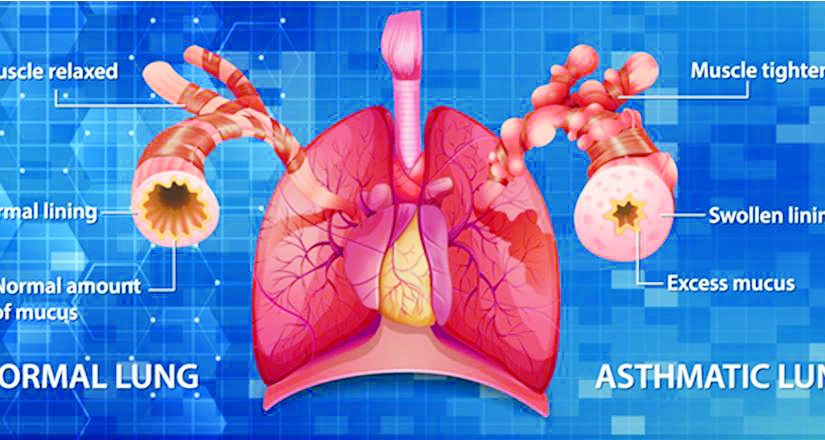Caption: HARD TO BREATHE: The difference between the normal and the asthmatic lung.
Intro: World Asthma Day is observed on May 3 every year. On this occasion Goan Observer caught up with Dr Amit Dias, Faculty at the Department of Preventive & Social Medicine, Goa Medical College & Hospital, to understand what causes asthma and how we can close the gaps in asthma care…
GOAN OBSERVER: What is the global and national situation of asthma and what is the aim of the campaign on World Asthma Day this year?
DR AMIT DIAS: It is estimated that there are around 300 million people worldwide with asthma. According to the WHO it led to more than 4.5 lakh deaths in 2019. It is one of the leading causes of morbidity and mortality in rural India and is projected to increase in the coming decades. Most of the deaths occur in the low and middle income countries where there is under-diagnosis and under-treatment resulting in a huge gap in asthma care. It usually affects children and it often affects their schooling and has a huge financial impact. The theme of World Asthma Day this year is ‘Closing Gaps in Asthma Care’ and focusses on ensuring that people are diagnosed in time and get appropriate care.
Q: What exactly is asthma?
A: Asthma is a chronic inflammatory condition leading to narrowing of the air passages in the lung and the tightening of the muscles around the small airways. The person presents with cough, wheeze, shortness of breath, chest tightness. The symptoms are intermittent and usually get worse at night or during exercise. A person during an asthma attack is like a fish outside water. The recent COVID-19 pandemic has taught us the value of our lungs and our breath. We should not take our lungs for granted and should take Asthma seriously.
Q: Is asthma treatable?
A: Yes, it is treatable. Although there is no cure for it, with appropriate management, people with asthma can live normal active lives. For adequate treatment, one should understand what triggers it, how to avoid those triggers and how to use the appropriate medications CORRECTLY. The word ‘CORRECTLY’ is crucial to closing the gap in Asthma Care. It is important to see a doctor for regular checkups and understand the correct methods for taking the medications and develop an Asthma Care plan. If you have any problems then you need to discuss it with your physicians as there are various devices such as spacers, autohalers etc which can help assist you.
Q: What are the possible triggers for Asthma?
A: There are various triggers for asthma. The first step if to understand what they are and take active steps to avoid them. Pollen, dust, mould, pet dander, smoking, including second hand smoke, food, environment air pollution, infection, cold weather, certain household chemicals, dust mites, cockroaches etc can trigger an attack. Even exercise and stress can trigger an episode and lead to exacerbations. One must be careful and try and avoid situations that can precipitate an attack. Talk to your doctor who may be able to suggest specific ways to do so.
Q: What is the treatment?
A: One should opt for INHALERS for taking treatment for Asthma. One should take both the rescue medicines, which give quick relief as well as the long term control medication, such as steroids, which ease the airway swelling and help prevent asthma symptoms. According to the WHO, only half the people with asthma has access to bronchodilators and one in five had access to steroid inhalers in the low and middle income countries. It is important to understand the steps of correctly using the inhalers in order to successfully manage Asthma.
The correct steps in using the inhalers are as follows.
Q Any final message for asthma sufferers and readers:
Dr Amit Dias: Do not ignore your health. The first step in closing the asthma Care gap, is getting to know about asthma. You need to understand the signs, understand the triggers and have a good relationship with your treating pulmonologist to ensure optimal care. We can make a difference educating everyone to live a quality life despite the disease.
